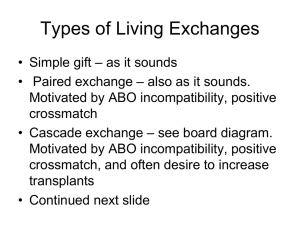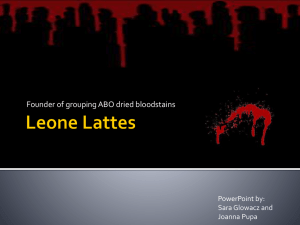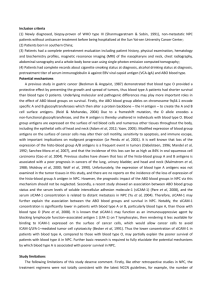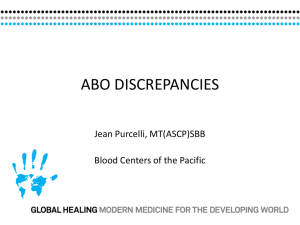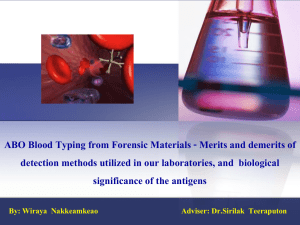frequency distribution of ABO blood groups
advertisement
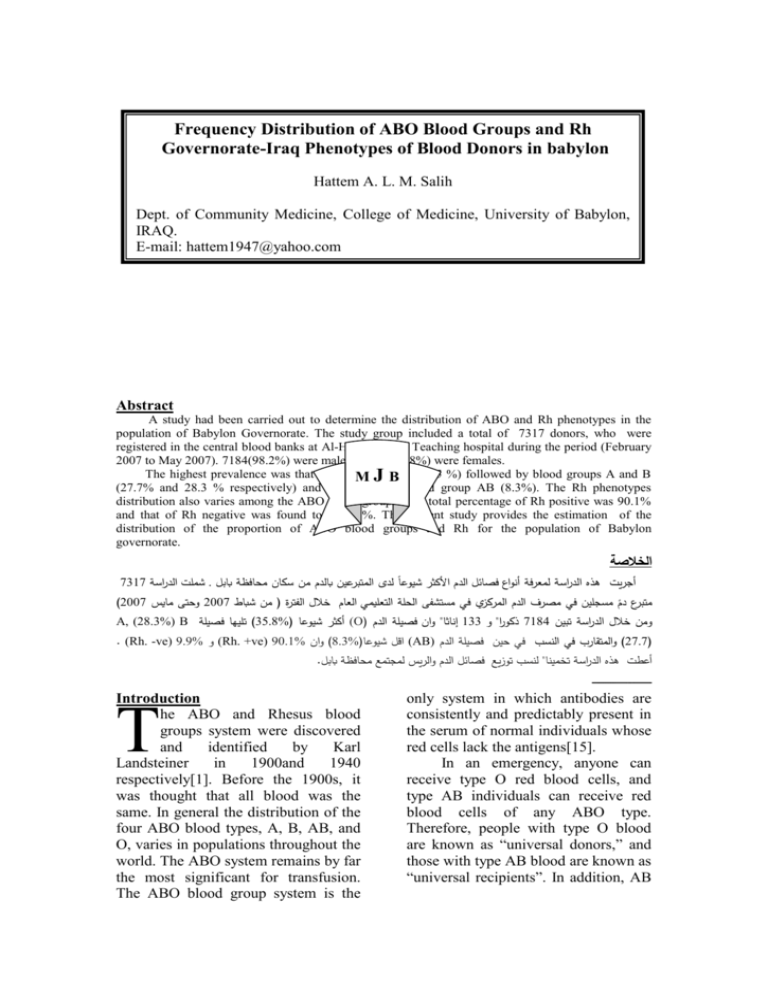
Frequency Distribution of ABO Blood Groups and Rh Governorate-Iraq Phenotypes of Blood Donors in babylon Hattem A. L. M. Salih Dept. of Community Medicine, College of Medicine, University of Babylon, IRAQ. E-mail: hattem1947@yahoo.com Abstract A study had been carried out to determine the distribution of ABO and Rh phenotypes in the population of Babylon Governorate. The study group included a total of 7317 donors, who were registered in the central blood banks at Al-Hilla General Teaching hospital during the period (February 2007 to May 2007). 7184(98.2%) were males and 133(1.8%) were females. The highest prevalence was that of blood Mgroup B O (35.5 %) followed by blood groups A and B (27.7% and 28.3 % respectively) and the lowest of blood group AB (8.3%). The Rh phenotypes distribution also varies among the ABO blood groups. The total percentage of Rh positive was 90.1% and that of Rh negative was found to be 9.9%. The current study provides the estimation of the distribution of the proportion of ABO blood groups and Rh for the population of Babylon governorate. J الخالصة 7317 شملت الدراسة. أجريت هذه الدراسة لمعرفة أنواع فصائل الدم األكثر شيوعا لدى المتبرعين بالدم من سكان محافظة بابل )2007 وحتى مايس2007 متبرع دم مسجلين في مصرف الدم المركزي في مستشفى الحلة التعليمي العام خالل الفترة ( من شباط A, (28.3%) B ) تليها فصيلة35.8%( ( أكثر شيوعاO( إناثا" وان فصيلة الدم133 ذكورا" و7184 ومن خالل الد ارسة تبين . (Rh. -ve) 9.9% ( وRh. +ve) 90.1% ) وان8.3%(( اقل شيوعاAB) ) والمتقارب في النسب في حين فصيلة الدم27.7( .أعطت هذه الدراسة تخمينا" لنسب توزيع فصائل الدم والريس لمجتمع محافظة بابل ـــــــــــــــــــــــــــــــــ Introduction he ABO and Rhesus blood groups system were discovered and identified by Karl Landsteiner in 1900and 1940 respectively[1]. Before the 1900s, it was thought that all blood was the same. In general the distribution of the four ABO blood types, A, B, AB, and O, varies in populations throughout the world. The ABO system remains by far the most significant for transfusion. The ABO blood group system is the T only system in which antibodies are consistently and predictably present in the serum of normal individuals whose red cells lack the antigens[15]. In an emergency, anyone can receive type O red blood cells, and type AB individuals can receive red blood cells of any ABO type. Therefore, people with type O blood are known as “universal donors,” and those with type AB blood are known as “universal recipients”. In addition, AB plasma donors can give to all blood types[15]. Knowledge of the frequencies of the different blood groups in Iraq and elsewhere is very important for Blood Banks and transfusion service policies. The distribution of ABO blood groups and Rh phenotypes varies from race to race. About 95% of African-Americans are Rhpositive, where indigenous Africans are virtually 100% Rh-positive Americans generally have frequencies of A, B, AB and O blood groups of 41%, 10%, 4% and 45% respectively [2]. In Kashmiri Population 'O' was the most prevalent blood group ie, 38.43%, while AB was the least and prevalent group ie, 6.55%. Majority 95.9% were Rhesus positive[3]. Among Western Europeans, 42% have group A, 9% group B, 3% group AB and the remaining 46% group O [4]. There is a big variations in the percentage of ABO blood types for some racial and ethnic distribution[16] as presented in the following table. Percentage of ABO Blood Types Reported Racial and Ethnic Distribution O A B AB % % % % Turks 43 34 18 16 Greeks 40 42 14 5 English 47 42 9 3 French 34 47 7 3 Germans 41 43 11 5 Malaysians 62 18 20 0 Japanese 30 38 22 10 Peru (Indians) 100 0 0 0 Indians (USA-General) 79 16 4 1 Indians (India-General) 37 22 33 7 Black foot (N. Am. Indian) 17 82 0 1 Aborigines 61 39 0 0 South Africans 45 40 11 4 PEOPLE GROUP The aim of this study is to estimate ABO blood groups and Rh phenotypes in the population of Babylon governorate. Materials and Methods Retrospective study done in Babylon governorate. The study group included a total of 7317 donors, 7184 were males and 133 were females. All donors were registered in the central blood bank at Al-Hilla General Teaching Hospital during the period of (February 2007 to May 2007). The information of this study depends on the records (archives) available in this blood bank, and these records are: Donors records which involve name, age, sex, time, and address. Blood groups and Rh records. Statistical analysis; the frequency distribution and proportions of ABO blood groups and Rh phenotypes were estimated from Babylon donors and analyzed contingency tables using standard methods rxc contingency chi-square test and confidence interval for population proportion[5]. Results Seven thousand three hundred and seventeen donors, with a mean age of 32.8 ± 9.04 years (range, 14 to 86 years), of whom 7184(98.2%) were males and 133(1.8%) were females. Table (1) shows the frequency distribution of ABO blood groups and Rh phenotypes according to age, which presents the most donators within aged 21to 40 years. The distribution of ABO blood groups in both Rh positive and negative among donors are illustrated in Table(2). It shows that the overall blood group(O) is the highest (35.8%) among both Rh positive and negative subjects, while the AB blood group was the lowest (8.3%) and more than 90% of the population turned out to be Rh positive. Table (2) also shows 95% confidence interval for the proportion proportion of A, B, AB, O and Rh phenotypes, the proportion of the ABO and the Rh phenotype was O+ (32.2%), followed by B+ (25.6%), A+ (25%), AB+ (7.4%). The lowest prevalence was that of AB- (0.9%). The prevalence of ABO blood group distribution studied in different counties of Babylon Governorate are illustrated in Table(3). The prevalence of group A positive was more in females (31.8%) as compared to males (24.9%), while group O positive was more frequent in males (32.2%) as compared to females (26.4%), Table (4). The prevalence of ABO blood group distribution studied in different times are illustrated in Table (5). Discussion This study has determined the frequency distribution of ABO blood groups and Rh phenotypes in Babylon governorate donors, these frequencies are used to estimate the ABO and Rh phenotypes in the population of Babylon. The results show no relationship between age and ABO blood groups (P <0.05). The ABO blood group shows group O is significantly higher compared with other groups, (P >0.01); while groups A and B are found to be almost equal, (P <0.05), and significantly more than group AB, (P >0.01). The prevalence of ABO blood groups and Rh phenotypes of donors among the four regions in Babylon shows some variations and similar trends to overall Babylon donors O>B≥A>AB and it shows a relationship between ABO blood groups and region, (P >0.05). There is no relationship between ABO blood groups and sex, (P <0.05) and also the prevalence of group A positive is more frequent in females (31.8%) as compared to males (24.9%), while group O positive is more frequent in males (32.2%) as compared to females (26.4%). There is no relationship between ABO blood groups and time of donation (P <0.05). In addition this study shows the prevalence of (Rh positive and negative) were (90.13%) and (9.78%) respectively, which is significantly different compared with other Iraqi studies in Basrah (P>0.01). The frequencies of Rh (+ve) and Rh (ve) in Basrah are (93.01%) and (6.99%) respectively[14], and with other countries show similar trends, Table (6). Usually, the distribution of ABO blood group varies from one population to another so the prevalence of ABO blood groups is varied compared with some other population countries appearing in Table (7). Group O higher than other groups as well as in other countries except Lebanon, Syria, and Jordan where group A is higher than O[9,10,11]. Conclusion The current study estimates the distribution of ABO blood groups and Rh in the population of Babylon Governorate. It is recommended to conduct similar studies in different parts of Iraq in order to determine the ABO blood group frequencies in different regions and sex, and hence we can estimate ABO blood groups and Rh phenotypes distribution of Iraqi population. Acknowledgements I wish to express my gratitude to the Manager of the Central Blood Bank in Babylon, Al-Hilla General Teaching hospital, Dr. Ihssan Ali Kadhom and his associated staffs, for providing help in the collection of blood group data. s well as the staffs of Community Medicine in College of Medicine, University of Babylon Dr. Amer W. Falah Dr. Ashraf M.A. Hussein, Dr. Ameer K. Hussein, and Dr. Basim A. A. Abd. References 1. Greenwalt TJ. A short history of transfusion medicine. Transfusion 1997;550-563. 2. Guyton AC, Hall JE. Textbook of medical physiology. Philadelphia, WB Saunders Company, 1996. 3. Javed Ahmad Latoo, , Naseer A Masoodi, Nisar Ahmad Bhat,; G Q Khan, Showkat A Kadla, The ABO and Rh Blood groups in Kashmiri Population. Indian Journal for the Practising Doctor, Vol. 3, No. 2 (200605 - 2006-06). 4. Pramanik T, Pramanik S. Distribution of ABO and Rh blood groups in Nepalese students: a report. Eastern Mediterranean Health J 2000; 6(1):156 – 158. 5. Daniel W. W. Biostatistics; A Foundation for analysis in health sciences.7th edition 1999; Wiley. pp. 176-177 and 588-592. 6. Bahaj A. A. ABO and Rhesus Blood Groups Distribution In Hadhramout Population. Hadhramout for science and Research(Issue Number 4) September 2003. 7. Bashwari LA, Al-Mulhim AA, Ahmad MS, Ahmed MA. Frequency of ABO blood groups in Eastern region of Saudi Arabia. Saudi Med J 2001;22(11):1008-1012. 8. Al-Bustan, S., El-Zawahri, M., AlAzmi, D., Al-Bashir, A.A., Miser, A., Geraci, T.K. and Wennberg, R.P. Allele frequencies and molecular genotyping of the ABO blood group system in a Kuwaiti population. Int. J. Hematol 2002; 75:147-153. 9. Nasif E. The incidence of blood groups in Lebanese. Lebanon Med J 1953;6:346-349. 10. Sakharov RS, Nofal’Kh K. The frequency of ABO blood groups and the expression of group antigens and isohemagglutinins in Syrian Arabs. Sud Med Ekspert 1996;39(2):34-36. 11. Hanania S, Hassawi D, Irshaid N. Allele frequency and molecular genotypes of ABO blood group system in Jordanian population. J Med Sci 2007;7(1):51-58. 12. Mohammad Anees and Mohammad Shabir Mirza. Distribution of ABO and Rh blood groups alleles in Gujarat region of Punjab, Pakistan. Proc. Pakistan Acad. Sci.2005; 42 (4); 233-238. 13. Shaikha Al-Arrayed, Durjoy K Shome, Nada Hafadh, Shawki Amin, Hussain Al Mukhareq, Mariam Al Mulla, Hassan Sanad, Fakhriya Ali Darwish. ABO Blood Group and Rhd Phenotypes in Bahrain: Results of Screening School Children and Blood Donors. Bahrain Medical Bulletin, September 2001,Vol. 23, No. 3. 14. Jenan Y. Taha. Frequency of Various Rh Antigens in Basrah Province, IRAQ. The Medical Journal of Basrah University. 2005, Volume 23(No. 1):53-55. 15. Ganong W. F. Review of Medical Physiology, 20th edition,2001; Ganong, pp. 520. 16. Beckman L. According to A Contribution to the Physical Anthropology and Population - as revised by BloodBook.com 12/07/2000; 07/22/2001; 04/10/2002; 05/22/2004. Table 1 Frequency Distribution of ABO Blood Groups and Rh Phenotypes according to Age to Babylon Population Donors. ABO and Rh Phenotypes A+ A- B+ B- O+ O- AB+ AB- 11.00 - 20.00 64 8 63 11 75 10 8 3 21.00 - 30.00 672 81 697 65 870 100 208 23 31.00 - 40.00 570 50 568 66 722 78 161 18 41.00 - 50.00 160 17 166 13 237 28 60 10 51.00 - 60.00 63 8 64 4 75 6 20 5 61.00 - 70.00 12 0 13 2 9 2 6 0 71.00 - 80.00 1 0 0 0 4 1 0 0 81.00 – 90.00 0 0 4 0 0 0 0 0 age (Year) Table 2: Prevalence of ABO and Rh Phenotypes in Babylon Population Donors. ABO & Rh No. of Phenotype Donors A Rh-positive 1829 A Rh-negative Prevalence 95 % confidence interval Lower limit Upper limit 25.00 % 0.231 0.269 198 2.70 % 0.016 0.038 Total A 2027 27.70 % 0.267 0.287 B Rh-positive 1871 25.60 % 0.237 0.275 B Rh-negative 194 2.70 % 0.020 0.034 2065 28.30 % 0.272 0.293 Total B O Rh-positive 2353 32.20 % 0.302 0.338 O Rh-negative 265 3.60 % 0.032 0.039 Total O 2618 35.80 % 0.347 0.369 AB Rh-positive 542 7.40 % 0.063 0.085 AB Rh-negative 65 0.90 % 0.005 0.013 Total AB 607 8.30 % 0.077 0.089 Rh-positive 6595 90.10 % 0.894 0.908 Rh-negative 722 9.90 % 0.092 0.106 Grand Total 7317 100.00 % Group O vs. other groups (P >0.01), Group A vs. Group B (P<0.05) Groups A & B vs. Group AB (P >0.01). Table 3 Prevalence of ABO Blood Groups and Rh Phenotypes different Districts. Distribution in County ABO & Rh Phenotypes Hilla Hashimya Mahaweel Musayeb No. % No. % No. % No. % A+ 899 26.2 322 24.4 248 24.2 211 22.6 A- 95 2.8 40 3.0 21 2.0 22 2.4 AB+ 249 7.3 117 8.9 76 7.4 60 6.4 AB- 39 1.1 8 0.6 7 0.7 8 0.9 B+ 895 26.1 326 24.7 247 24.1 242 25.9 B- 95 2.8 24 1.8 33 3.2 21 2.2 O+ 1048 30.6 435 33.0 349 34.0 332 35.5 O- 109 3.2 48 3.6 45 4.4 38 4.1 Table 4 Prevalence of ABO Blood Groups and Rh Phenotypes according to Sex. sex ABO & Rh Female Male % % A+ 31.8 24.9 A- 1.6 2.7 AB+ 7.0 7.4 AB- 0.8 0.9 Phenotypes Distribution B+ 26.4 25.6 B- 3.1 2.6 O+ 26.4 32.2 O- 3.1 3.6 Table 5 Prevalence of ABO Blood Groups and Rh Phenotypes Distribution Among Months. Month ABO & Rh February March April May Phenotypes No. % No. % No. % No. % A+ 265 25.7 511 25.3 536 24.7 517 24.7 A- 27 2.6 51 2.5 58 2.7 62 3.0 AB+ 68 6.6 162 8.0 168 7.7 144 6.9 AB- 15 1.5 11 0.5 13 0.6 26 1.2 B+ 288 27.9 536 26.5 536 24.7 511 24.4 B- 27 2.6 54 2.7 60 2.8 53 2.5 O+ 296 28.7 632 31.3 729 33.6 696 33.2 O- 45 4.4 63 3.1 72 3.3 85 4.1 Table 6 Prevalence of Rh Phenotypes in some Arabic Countries compared with the present study Country Rh-positive % Rh-negative % Present study 90.13 9.87 Hadhramout[6] 92.90 7.10 Saudi Arabia[7] 91.50 8.00 Kuwait[8] 92.50 7.50 Bahrain 91.80 8.20 Table 7: Prevalence of ABO Blood Groups compared with some other Countries. O A B AB % % % % Present study 35.78 27.70 28.22 8.30 Hadhramout[6] 51.50 29.60 16.60 2.30 Saudi Arabia[7] 52.00 24.50 17.00 4.00 Kuwait [8] 35.00 29.00 23.00 14.00 Lebanon[9] 36.11 47.25 11.52 5.12 Syria[10] 37.50 46.25 13.13 3.12 Jordan[11] 36.62 38.36 18.04 6.98 55.96 17.40 22.29 4.35 Bahrain[13] 46.80 41.70 8.60 3.00 America* 45.00 40.00 11.00 4.00 Country Gujrat (Pakistan) [12]
